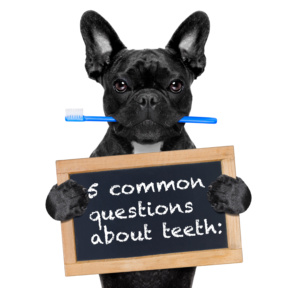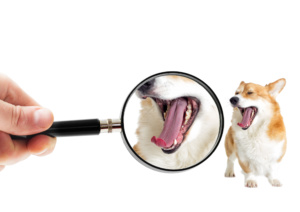Did you know that dental disease is the most common medical problem affecting dogs and cats in the U.S.? According to the American Veterinary Dental College (www.avdc.org) most dogs and cats have some degree of dental disease by three years of age. But dental disease is not just about stinky breath. Bad teeth can cause pain, and gum infections can spread to other organs, such as the kidneys, liver and heart, which may result in serious health problems.

- How do I know if my pet has bad teeth? Most people can tell when their dog or cat has bad breath, but in many cases bad breath indicates that infection is already set in. The best thing to do is to have your veterinarian examine your pet’s mouth at every yearly examination and schedule a preventive dental cleaning when the signs start. At home, you can monitor your pet’s teeth for tartar build up and their gums for swelling and redness.
- Why is my dog’s dental cleaning so expensive? Veterinary professionals often hear “my dental cleaning is nowhere near this much!”. Let’s think about that for a minute. When we go to the dentist for a dental cleaning, we are awake for the procedure, cooperate by opening and closing our mouths when asked (well, most of us anyway), and insurance covers most if not all the cost of the visit. In contrast, dogs and cats require anesthesia and therefore pre-anesthetic work up to make sure that the sedatives and anesthetics are suited for each individual patient. A full dental procedure, including dental radiographs and cleaning can take anywhere between 30 minutes to an hour and half. Many patients need extractions, which adds more time under anesthesia. All this time, effort, and diagnostics with one big difference from human dentistry: no dental insurance. Human dental procedures are in fact much more expensive than animals, we just don’t always see the total expense.

- How often do dogs and cats need professional dental cleanings? Even when we brush our pet’s teeth and feed proper diets, pets need regular dental care. Think about it, we brush our teeth twice a day and use dental floss and still go to the dentist (or should) every 6 months. The exact time between dental cleanings is not the same for every pet, as some need it more often than others. Most dogs benefit from a yearly dental cleaning while others can wait several years in between procedures. Dog’s with severe dental disease may require additional cleanings and extractions as early as 3 to 6 months after the first one. Waiting until there is a problem results in pain and discomfort for our beloved pet, a higher chance of need for extractions, longer anesthesia time, and significantly higher expenses for the procedure, so having a dental cleaning at the first signs of dental problems is the best practice.
- “If you pull my pet’s teeth, how are they going to eat?” My answer is “Better than they did before!” Think about it: have you ever had a toothache? It hurts like crazy to chew your food. Our pets adjust to dental pain by not chewing their food, so losing the damaged teeth improves their overall health, comfort and happiness as they no longer have a pounding, constant pain in their mouth.
- Who can perform a dental cleaning? Only a licensed veterinarian or a veterinary technician under the supervision of a licensed veterinarian can perform dental procedures in animals (there may be some variations between laws in each state). Individuals, such as groomers, who perform dental procedures like chipping away excess tartar, may cause serious problems like gum damage, spread of infection, and chipping of teeth, not to mention that in many states this is an illegal practice.
If you would like to submit a topic or specific question you would like for Dr. G to address in this blog, let us know by sending an email with Rascal’s Corner in the subject line.
Email to askDrG@generationwags.com
To view all posts in Rascal’s Corner click here!



